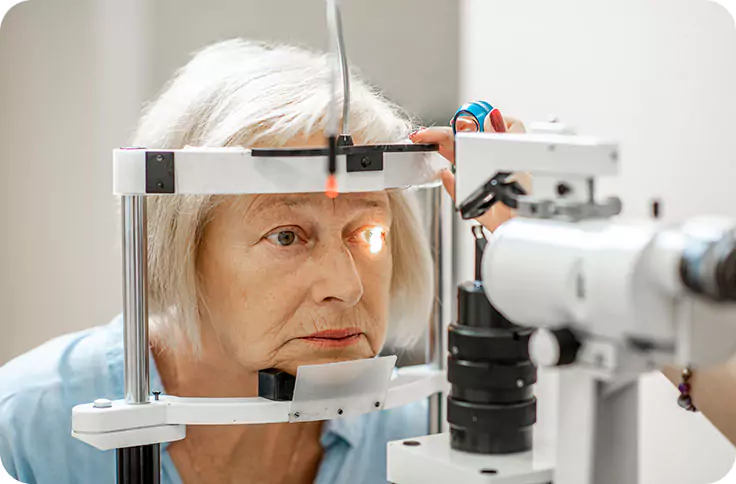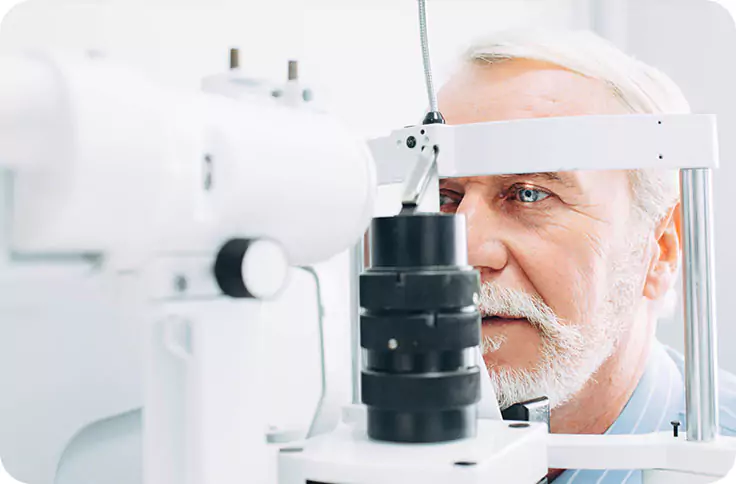Open Angle Glaucoma: Treatment, Signs and Symptoms, Medications, Blindness And More
Open-angle glaucoma can lead to blindness if not treated. Learn about its symptoms, medications, and treatment options to protect your vision.
Jan 8, 2023
Glaucoma
We'd love to tell you more
We won't bore you with the details, but Health Canada requires you to sign in.
By proceeding you agree to our Terms of Use & Privacy Policy
In this article
- What is open-angle glaucoma?
- What is the difference between open and closed-angle glaucoma?
- Can open-angle glaucoma be cured?
- What is the treatment for open-angle glaucoma?
- What are the early warning signs of open-angle glaucoma?
- What medications should be avoided with open-angle glaucoma?
- How serious is open-angle glaucoma?
- Will you go blind from open-angle glaucoma?
- How fast does open-angle glaucoma progress?
Glaucoma is an eye disease that can damage the optic nerve in the eye. The optic nerve is responsible for capturing and sharing visual details with your brain. Glaucoma causes increased pressure inside your eye (increased intraocular pressure), which in turn damages the optic nerve. If untreated, this may lead to loss of vision or blindness. However, if you start treatment early, you may be able to prevent vision loss and slow the progression of the disease.
Glaucoma can be classified into various types. The two most common types of glaucoma are:
- Open-angle glaucoma
- Acute angle-closure glaucoma (also known as narrow-angle closure glaucoma)
This article will discuss open-angle glaucoma, its symptoms, and treatment options. To know more, keep reading the article.
What is open-angle glaucoma?
Open-angle glaucoma is the most common form of glaucoma. With this type of glaucoma, fluid builds up in the eye because the “drain” for fluid (called the trabecular meshwork) is partially blocked. This results in an increase in pressure (intraocular tension). The increase in intraocular pressure causes damage to the optic nerve. Open-angle glaucoma slowly progresses with time, and most people don’t have any symptoms until a large portion of their optic nerve is already damaged.
What is the difference between open and closed-angle glaucoma?
Open-angle glaucoma makes up 90% of all glaucoma cases. In open-angle glaucoma, the “drain” for fluid in the eye is partially blocked. This results in a build-up of fluid, which in turn increases the intraocular pressure. The increase in intraocular pressure causes damage to the optic nerve.
Closed-angle glaucoma, which is commonly known as narrow-angle glaucoma, is caused by the complete blockage of drainage canals in the eye. The blockage results in a sudden rise in pressure in the eye (intraocular pressure). Narrow-angle closure glaucoma is rarer. It can develop quickly and requires immediate medical treatment.
Can open-angle glaucoma be cured?
Open-angle glaucoma usually occurs in both eyes and worsens with time. There is no cure for it; however, if detected early, the progression of the disease can be slowed or delayed.
What is the treatment for open-angle glaucoma?
Damage to the optic nerve caused by glaucoma is irreversible. The best way to prevent vision loss is regular eye checkups. With regular check-ups, your doctor can start treating high intraocular pressure before you have any symptoms.
Depending on the progression of the disease, your treatment options may include any of the following:
- Eyedrops: The treatment of glaucoma often begins with eye drops. These are used to reduce eye pressure and help in improving the fluid drainage in your eye by decreasing fluid production. The medications may include:
- Beta-blockers, e.g. timolol (these medications decrease the production of fluid in your eye)
- Carbonic anhydrase inhibitors, e.g. dorzolamide and brinzolamide (these medications decrease the production of fluid in your eye)
- Alpha-adrenergic agonist, e.g. brimonidine (these medications reduce the production of aqueous humor and increase the outflow of the fluid in your eye)
- Rho-kinase inhibitors, e.g. netarsudil (these medications decrease the eye pressure by inhibiting rho kinase enzymes, which is responsible for an increase in fluid)
- Prostaglandins, e.g. latanoprost, travoprost ( these medications increase the outflow of the fluid in your eye, which helps in reducing the eye pressure)
- Cholinergic agent,s e.g. pilocarpine (these medications increase the outflow of the fluid from your eye)
- Oral medication,ns e.g. acetazolamide (these agents reduce eye pressure in emergency situations when eye drops cannot be used)
- Surgeries(various laser therapy and surgical procedures intended to improve the drainage of eye fluid and reduce eye pressure are used when medications fail to do so)
Depending on your condition and eye pressure, one or more treatment options may be prescribed.
What are the early warning signs of open-angle glaucoma?
The early stages of open-angle glaucoma usually do not show any symptoms. Damage to the optic nerve often occurs before you become aware of it. However, symptoms may appear that include:
- Nausea
- Redness in the eye (white part)
- Decrease vision
- Loss of peripheral vision (tunnel vision)
- Swollen cornea
- Pupil dilation to a medium size that does not change with an increase or decrease in light exposure
What medications should be avoided with open-angle glaucoma?
The most well-known medications that increase eye pressure are steroids, which should be avoided in open-angle glaucoma. They can cause permanent blockage of the eye’s drainage system. If you have been diagnosed with glaucoma, check with your doctor or pharmacist before taking steroid medication.
A variety of other medications can affect glaucoma and put you at risk of worsening your vision. Hence, before taking any other medications, you should always consult your doctor or pharmacist.
How serious is open-angle glaucoma?
Open-angle glaucoma is a slow, progressive disease due to an increase in eye pressure, which causes damage to the optic nerve. If left untreated, open-angle glaucoma may eventually cause blindness.
Will you go blind from open-angle glaucoma?
Most people with open-angle glaucoma do not completely lose their vision in their lifetime. However, it is possible, especially if it is left untreated over a long period of time. The best way to prevent losing your sight is to have regular eye check-ups and follow your treatment plan to delay disease progression.
How fast does open-angle glaucoma progress?
Open-angle glaucoma is a slow degenerative disorder of the eye which causes gradual damage to the eye. How fast the disease progresses varies from person to person. In one study, about 1 in 3 patients progressed to advanced glaucoma after 10 years.
Join Pocketpills.
Get care that fits your life. See a doctor, order prescriptions, and manage your health from home, on your schedule.
Get StartedSimilar Articles

Narrow Angle Closure Glaucoma: Can It Cause Blindness? Cure and Treatment
Glaucoma is an eye condition that can damage the optic nerve in the eye. The optic nerve is responsible for capturing the visual details and sharing them with your brain. Glaucoma happens when there is increased pressure inside your eye (increased intraocular pressure) which damages the optic nerve. If left untreated, this may lead to loss of vision or blindness. However, with prompt diagnosis and treatment, you may be able to prevent vision loss and slow the progression of disease.
Jan 8, 2023

Open Angle Glaucoma: Treatment, Signs and Symptoms, Medications, Blindness And More
Glaucoma is an eye disease that can damage the optic nerve in the eye. The optic nerve is responsible for capturing the visual details and sharing them with your brain. Glaucoma causes increased pressure inside your eye (increased intraocular pressure), which in turn damages the optic nerve. If untreated, this may lead to loss of vision or blindness. However, if you start treatment early, you may be able to prevent vision loss and slow the progression of the disease.
Jan 8, 2023

